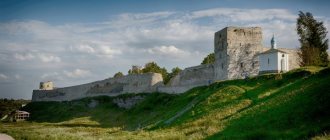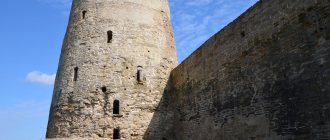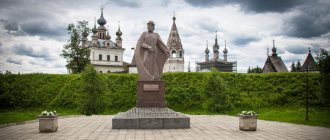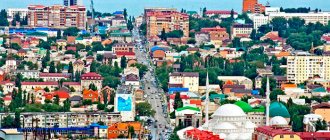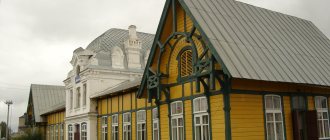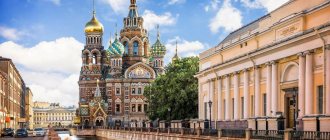Verkhoturye is a relatively small city with a population of 8815 people according to the latest census in 2022. The city is located on the left bank of the Tura River, in a picturesque location on the eastern slopes of the Middle Urals. The city has many historical attractions. The city was founded in 1598, its location coordinates: northern latitude: 58.859531, eastern longitude: 60.815496.
The height above sea level is 101 m. Verkhoturye, whose attractions are located not only in the city, but also in its surroundings, is located at a distance of 306 km from the city of Yekaterinburg. Verkhoturye today is the administrative center of the Verkhoturye district of the Sverdlovsk region.
The main events that happened to the city:
| 1600 | Verkhoturye becomes a customs fortress through which all goods from Siberia pass. |
| 1708 | By order of Peter I, the state is divided into 8 districts, Verkhoturye is part of Siberia. |
| 1674 and 1738 | Severe fires occur in Verkhoturye and cause significant damage to the city. |
| 1763 | The customs fortress in Verkhoturye ceases to exist. |
| 1783 | The city was transferred to the Perm governorship. |
| 1906 | The railway connection was built and launched. The Bogoslovskaya station is open 8 km from Verkhoturye. |
| 1917 | Power in Verkhoturye passes to the Bolsheviks. |
| 1918 and 1917 | The power of Verkhoturye passes to Kolchak. |
| 1926 | Verkhoturye loses its urban status and becomes a settlement. |
| 1947 | On the 350th anniversary of the city, Verkhoturye was again given city status. |
| 1963 | It is part of the Verkhoturye region. |
Verkhoturye, whose sights include modern and ancient architectural monuments, is the smallest city in the Sverdlovsk region.
Top 10 most interesting sights of Verkhoturye
Scroll:
- Temple of the Archangel Michael located in Merkusheno on the street. Monastery House 3. The white stone Temple was built on the site of a wooden church that burned down in 1777. The main attraction of the temple is the relics of the Great Martyr Constantine of the Epiphany.
- 1 The Kremlin in the Urals , built in 1598 in Verkhoturye. This is the smallest of all the built Kremlins. Its ensemble includes the Trinity Cathedral and the nature reserve.
- The Convent of the Intercession is located on the street. Senyansky House 3. Its foundation date is 1621. After a fire in 1651, it was rebuilt and consecrated. Valid until today.
- Hermitage Svyato-Kosminskaya is a monastery located in the village of Kostyleva in the Verkhoturye region. The temple was founded and consecrated in 2003 in honor of blessed Cosmas of Verkhoturye.
- Holy Cross Cathedral is located on the street. Central. It was erected in 1913 for the 300th anniversary of the Romanov dynasty. It contains the relics of Saint Simeon.
- The Transfiguration Church is a monument of architectural classicism. It was built in 1829 according to the design of Vasily Stasov and rises on Preobrazhenskaya Square.
- Gate Church of Anna and Simeon located in the Central Quarter of Verkhoturye. It was built in 1856 in the Old Russian style and is part of the ensemble of the Nikolaev Monastery.
- Church of the Intercession of the Holy Virgin is located on the street. Komsomolskaya. The church was founded in 1898 and completed in 1902. The church was closed from 1924 to 1991. Since 1992 it has been operating for its intended purpose until today.
- The building of the women's gymnasium is located in Verkhoturye at the address: st. Sovetskaya house 10 on the west side of the Spaso-Resurrection Church. This is a 2-story building, built in 1905 following the example of the Alexander Tyumen School.
- The "Public Assembly Building" is an architectural monument of the region. It is located on the street. Marx house 2, and was built in Art Nouveau style. Today the building houses a branch of the College of Economics.
#11 Ruins of St. John the Baptist Church
The ruins of St. John the Baptist Church are one of them.
The temple was built in 1754-1768. Now it’s hard to imagine that this temple adorned the city for more than 150 years. Only experts will see here hints of a magnificent example of the Ural Baroque: the structure, the remains of decoration on the facades, traces of paintings in the interior refer to the best churches of Solikamsk and Dalmatovo . What the temple looked like before 1917 can be seen in photographs by Prokudin-Gorsky .
You can imagine the reconstruction project of 2012.
Or you can look at the restored churches in Severouralsk and Karpinsk , which were built by the same artels according to the same project, commissioned by Pokhodyashin . It was thanks to Maxim Mikhailovich that settlements appeared in the 18th century, which would later become Severouralsk , Karpinsk ; Novolyalinsky and Krasnoturinsky districts .
Maxim Mikhailovich began with wine farming, and by the 1780s his factories provided more than a third of Russian copper. We don’t know whether the merchant-builder built the churches from the heart or as an indulgence, we don’t know, but I assure you that studying their style and history is a fascinating thing, just like the biography of Pokhodyashin . By the way, the children did not continue their father’s work. One of his sons, Gregory , is known as the largest donor to the projects of Nikolai Novikov , educator, freemason and public figure.
In addition to the connection with Maxim Pokhodyashin , the history of the convent is known by the names of Maria Khlopotova (the exiled bride of Mikhail Fedorovich Romanov , she was kept here in 1619-1621), and Princess Anna Dolgorukaya (she was also in exile here in 1740-1742). In general, they love the theme of exiled brides here, and the museum has a separate stand - a reconstruction with a weeping beauty.
Architectural objects and monuments of Verkhoturye
The territory of Verkhoturye is famous for its large number of architectural and modern monuments that have survived to this day.
Memorial to the Great Patriotic War on the station square
The memorial is located in the center of the station square. It is considered the main monument of the Second World War and serves as a place for laying flowers.
Verkhoturye, in addition to a complex of church buildings, has a Great Patriotic War Memorial.
On a large pedestal there is a sculpture of a Soviet army soldier holding a child in his arms.
Memorial to the Great Patriotic War at the monastery wall
The memorial is located in the Nikolaevsky Monastery and is dedicated to the soldiers of the Second World War. The memorial depicts the image of a soldier carved from a huge stone. At its foot are memorial plaques with the names of the victims.
Tractor monument
Near the entrance to the local history museum there is a monument to the ST3-15/30 or STZ-1 tractor.
This is a small arable tractor, 1 of 1 put into mass production on the assembly line. This is a significant event in the history of industrialization of the country.
House of Malyshev I.M.
House of Malyshev I.M. is an architectural monument. It is located on the street. Malysheva 32, at the intersection with st. Kushvinskaya. A famous revolutionary, a participant in the introduction of Soviet power in the Ural region, was born here. Malyshev was an organizer of trade unions and 1 labor commissar for the Ural region.
He was the commander of the Red Guard detachments and a participant in military operations aimed at suppressing the White Guards in Troitsk under the command of A.I. Dutova. In mid-July 1918, in the village of Syrostan, the revolutionary was captured and killed.
House of Balashov A.M.
House of A.M. Balashova is located on the street. Lenin in house 31. This is a 2-story red brick building, which is an architectural monument of the last century.
Balashov is the chief architect and builder of the Cathedral of the Exaltation of the Cross.
#18 Church of the Nativity in the village of Deryabino
The Russian word "deryaba" had the meaning of a bully, a hooligan; and in 1680 the Deryabin became the founders of a settlement on the way from Verkhoturye to Alapaevsk . Until now, the surname “Deryabins” is the most common among village residents.
The temple was founded back in 1794, there are few facts about its history, so I will digress into the lyrics and photographs in which I tried to capture the spirit of this place, the spirit of a very touching ship-temple, a monument to Faith, only partly church, but mostly faith to the strength of those same fighters and bullies who in the 17th century mastered the routes to Siberia.
the village of Krasnogorskoye , in Prokopyevskaya Salda (the local temple is associated with the legends of Governor Gagarin ), in Ust-Salda and the village of Piya
will be of interest . You can read about them in other publications, but within the framework of our journey and report on it, additional temples will already be a serious overdose.
Sretenskaya Church, village. Prokopyevskaya Salda. According to legend, it was built by the descendants of the first Siberian governor Gagarin.
Peter and Paul Church, p. Ust-Salda
In general, from the moment you arrive in Verkhoturye , a feeling of farce covers you - standing on the central square of the town, you can see the huge Cathedral of the Exaltation of the Cross (the youngest and most fashionable church in the city’s Orthodox circles), the lace ligature of the Trinity Cathedral (the oldest church), and the ruins of several churches of the 18th century, which are being destroyed more and more every year. The contrast between several objects in which huge amounts of money have been invested over the past 20 years, and hundreds (I was not mistaken) of buildings that created the historical flavor of a provincial town is amazing. Add to this the extremely undeveloped infrastructure - and a trip to Verkhoturye and the region will no longer seem so attractive... Nevertheless, it is worth going here, if only for the sake of the museum.
Historical monuments of Verkhoturye
Verkhoturye, whose sights attract many pilgrims, is popularly called the “Spiritual Capital of the Ural Region.”
Znamenskaya Church
On the territory of Verkhoturye on the street. Sverdlov there is the “Znamenskaya Church” built in 1781. A stone 2-story building was built on the site of a wooden structure that was destroyed by fire in 1778. In 1808, the church was consecrated in the name of the great martyrs Laurus and Florus.
The following villages were included in this parish:
- Kamenka;
- Not good;
- Shvedova;
- Furina.
The church served as a parish for 600 parishioners. In 1922, the church was looted and destroyed. In 1935, the church was closed and the building was abandoned.
Don't miss the most popular article in the section: Metro Nizhny Novgorod. Diagram, map, description.
Church of the Nativity of John the Baptist
On the territory of Verkhoturye on the street. Club 1 is the Orthodox Church of St. John the Baptist, founded in 1754. This is a brick 2-story building, built in the Baroque style with a 2-light, 5-domed quadrangle and a 5-sided altar. In the church there was the Forerunner's throne at the top, the Varvara throne at the bottom, there is a bell tower, a refectory and a dome of complex shape.
In 1920, the church, like all the others, was closed. In 1940, the church was looted and partially destroyed. Today, the lower part of the building has survived and is gradually collapsing.
Assumption Church at the city cemetery
The Assumption Church is a historical monument. It was founded in 1799 and was built over 16 years. It was built at the insistence of Archbishop Varlaam the Right Reverend during the reign of Paul I. Upon completion of construction in 1815, on the orders of the bishop, the temple was consecrated. Despite the modesty of the facade and decoration, services of the church clergy were performed here.
During Soviet rule, the Holy Cross Church and the Assumption Church were closed.
The holy relics of Simeon kept in the church were taken away. The revival of the temple took place in the post-war year 1946. In 1995, the church was annexed to the St. Nicholas Monastery. In 2012, the church was given the status of an independent parish. Since 2015, the rector of the church has been Priest Sergei Demin.
Church of the Resurrection of Christ
The church was founded on March 13, 1786 and was built in mixed classicism and baroque styles. The upper church was consecrated on November 22, 1786, the lower church on July 29, 1806. This is a 2-story stone building located on the street. Svoboda house 2.
The church is distinguished by a two-tier bell tower. In 1922 it was looted, and in 1925 it was finally closed. In 1930, the bell tower and dome were demolished and destroyed.
Type of clothing
Photo: clothes for visiting church
In general, special attire is not required to visit Verkhoturye. You just have to remember that if you go to monasteries or churches, you need appropriate clothing: men wear only trousers (shorts are not suitable), women and girls need to wear long skirts and headscarves. If for some reason you did not take such clothes with you, they are given at the entrance to the monasteries for the duration of your visit. It is better to choose shoes without heels - you will have to walk and stand on your feet a lot. Girls are not recommended to use lipstick and any other cosmetics, because... It is forbidden to touch the shrine of Simeon of Verkhoturye and the icons with makeup on your face.
Photo: clothes for visiting church
Which museums in Verkhoturye are worth visiting?
Sights and exhibits collected in Verkhoturye museums will help you understand the culture and customs of the Ural region.
Orthodox Museum of St. Nicholas Monastery
The Museum of Orthodoxy is located on Voinskaya street, house 1 “a”, next to the monastery. The opening of the museum took place in 1996.
In addition to the exhibition hall, where exhibits of the general history of the region are collected, it is divided into 4 thematic halls:
- History of the Nicholas Monastery over the last 4 centuries - vestments of priests, icons and church utensils.
- "Cathedral of the Exaltation of the Cross" and its surrounding territory.
- Development of the Ekaterinburg diocese of the late XIX - early XXI centuries.
- Convents and monasteries today.
Rare copies of documents and books are collected here. The main attraction is the gospel, published in the era of Tsar Mikhail Fedorovich. Museum opening hours are from 9 a.m. to 5 p.m. daily
Verkhoturye Museum of Local Lore
The Museum of Local History is located in the center of Verkhoturye on the street. Kuznechnaya 14, and is a recognized architectural monument of the region. The museum opened in 1921 in a house built in 1913. Before the museum was founded, the building was called the “House of Reception of Honored Guests.” It was built during the reign of Emperor Nicholas II.
The Russian monarch was supposed to visit Verkhoturye and the building was intended for his reception and residence. In 1935, the museum was disbanded and abandoned for a long time. The beginning of its restoration dates back to 1977.
Verkhoturye Historical and Architectural Museum-Reserve
The museum reserve was founded at the very beginning of the 21st century and is a follower of the local history museum.
The museum exhibits of the reserve include objects of federal and regional cultural heritage:
- Kremlin on the coast of Tura;
- "House of Reception of Honored Guests."
Also part of the Kremlin, the exhibits of the reserve included:
| Holy Trinity Cathedral | Founded 1703 |
| Voivode's mansion | Founded in 1801 |
| Chambers for decrees | Founded 1825 |
| Local Treasury | Founded 1913 |
| State barns | 1703 foundation and reconstruction 1913 |
At the beginning of the 21st century, thanks to the launch of the Verkhoturye-Spiritual Center of the Urals program, a large number of historically significant objects of the city and its environs were restored and recreated.
Simeonovskoye Compound in Merkushino
The Tikhvin Convent is located in a small village called Merkushino. Saint Simeon of Verkhoturye lived here for some time. An ensemble of 2 churches was erected in honor of him. In 1930 the churches were closed. Grain was stored in the Temple of Simeon for some time, and the Church of St. Michael the Archangel was blown up. In the early 90s, a decision was made to restore and restore them.
Today, churches hold daily services.
20 novices permanently live on their territory, who keep order and receive pilgrims who come to see the local landmark. Cathedrals, churches, temples of Verkhoturye. Verkhoturye, whose attractions include “Russia’s smallest Kremlin” and many churches, is called the “Ural Jerusalem.”
Church of All Saints of the Urals and Siberia
Construction of the Temple lasted 3 years from 2002 to 2005. This is the first temple in the Urals, dedicated to the Siberian righteous. It was erected on the banks of the Tura River not far from the convent near the village of Merkushino. The place where the temple was built was not chosen by chance; according to ancient records, it was here that the righteous Simeon fished.
The building is built of logs, has gilded crosses and carved decorative trims.
Holy Trinity Cathedral
“The Cathedral of the Life-Giving Trinity” is included in the list of architectural monuments of world significance. Construction of the cathedral began in 1703 and lasted 9 years until 1712. The cathedral is part of the ensemble of the Verkhoturye Kremlin.
The main attraction of the cathedral is the uniquely painted interior walls. Monk John from the city of Tobolsk worked on the painting. The pride of the cathedral is a huge bell weighing almost 2 tons.
Church of St. Nicholas the Wonderworker
The monastery at the Church of St. Nicholas the Wonderworker, founded in 1604, is located on a hill between the rivers called Sviyaga and Kalachik. In the fall of 1704, the relics of the righteous Simeon were transported to the monastery from the village of Merkushino. Until 1917, an almshouse and an Orthodox school operated at the cathedral.
In 1924, the cathedral was closed, and juvenile delinquents were kept in the building. In 1990, a decision was made to return the cathedral buildings to the church and restore them. It was possible to restore 3 cathedrals, a monastery fence and a tower.
#2 Trinity Cathedral
Trinity Cathedral , whose bell tower we climbed at the end of the museum tour, is famous as the first stone church in our region. It was built from 1703 to 1709 by Solikamsk masons under the guidance of Moscow craftsmen; by decree of Peter I it was allowed to build a temple of stone. Let me remind you that in those days, stone construction was prohibited in Russia , since stone craftsmen from cities and villages were sent to the construction of the new capital. An exception was made for Verkhoturye
The Trinity Cathedral is perfectly preserved; since 1960 it has been included in the list of historical monuments subject to protection as a monument of national importance. And it is this temple, from a historical point of view, that is the center of Verkhoturye - both as the first stone one, and as included in the structure of the Kremlin , and simply as a very beautiful building.
For a small donation, guests are allowed into the bell tower, and the views from it are simply fabulous! From the Kremlin it’s literally two steps to the next point of our plan.
Parks, gardens and squares of Verkhoturye
On the territory between the villages of Otradnovo and Krasnogorskoye, Verkhoturye district, there is a natural monument “Vyazovsky uremnye forests”. This is a monument of regional significance, covering an area of more than 4 hectares. Smooth elm primarily grows in the park.
The Otradnensky cedar trees natural park is located in the Verkhoturyevsky district near the village of Otradnoye at the mouth of the Otradnovka River. The park was founded in 1983; cedar trees mainly grow on its territory.
In the near future, it is planned to build a family recreation complex called “Apple Orchard” on the banks of the Tura River. Among a large number of fruit trees on an area of 16 hectares, attractions, recreation and trading areas will be built.
Modern objects of Verkhoturye, interesting to visit
The construction of the Verkhoturye hydroelectric power station on the Tura River began during the Second World War in 1943 on the station square. The completed power plant structures were put into operation in stages, starting from 1949 to 1958. The Verkhoturskaya HPP was built to provide local gold mining enterprises with electricity.
The power of the hydroelectric power station is 7 MW, which allows it to generate 33 million kW per hour daily. 3 hydraulic units located vertically produce water pressure of up to 15 m. A memorial sign in honor of the 400th anniversary of Verkhoturye was erected on Station Square in the park of culture and recreation called “Skvar Shkolny”, on Sovetskaya Street. The bronze monument is located in the center of the square in front of the Trinity Church.
Nearby there are benches for tourists to rest and several tents selling souvenirs. At the top of the monument there is a symbolic emblem of Verkhoturye, under it is a portrait of Tsar Fyodor Ioannovich, on the other side there is a laudatory inscription about the governor of Verkhoturye E. E. Rossel.
A little history
This Ural city was built on the Ture River, which flows in the Sverdlovsk region. A little earlier the city belonged to the Perm province.
The history of Verkhoturye dates back to 1597, when Ermak conquered Siberia and the Urals. There was originally a fortress of the Maxi people here. Then it was converted into a prison. Then Verkhoturye was made a customs house. All the goods that Siberia is rich in passed through this settlement.
Two government decrees contributed to the flourishing of the city:
By decree, the Russian state monopolized the fur trade. All transactions with Russian merchants, maxi and local residents were made here, at Gostiny Dvor.
By decree, a Yamsk service was established, the paths of which crossed Verkhoturye. This was very beneficial for the city - the construction of other means of communication nearby, in the same area, was prohibited.
In the middle of the 17th century, the city was intensively developed and built. The population grew, residential areas filled up, churches and monasteries were built. Trade flourished.
In 1753, trade gradually subsided due to the abolition of duties. And by the middle of the 19th century, Verkhoturye ceased to be a trading center. Now this area is becoming a spiritual center: the number of monasteries and temples is growing.
Top 5 places suitable for holidays with children
There are several entertainment options for children in Verkhoturye:
- Visit to the theater located on the street. Soviet House 8. The theater is open daily from 9 a.m. to 9 p.m.
- Visit to the cinema located in the building of the Culture Center on the street. Soviet House 1. The cinema supports 2D and 3D formats, open daily from 8 a.m. to 8 p.m. Ticket prices range from 200 to 270 rubles.
- Children's and youth sports ski resort, located on the street. 70 Let Oktyabrya House 4. Skiing is available daily from 2 to 9 p.m.
- Inspection of the suspended pedestrian bridge across the river at the Trinity Cape rock, built in the late 40s. XX century. The bridge is the hallmark of the city and a kind of observation deck with all-round visibility.
- Inspection of the railway station building at Verkhoturye station, which is considered one of the most beautiful stations in Sverdlovsk and is recognized as a cultural heritage site of the region. The station building was opened in 1903, 7 km from Verkhoturye in the village of Privokzalny.
On a note
Women should stock up on a scarf and a long skirt, and their makeup should be modest.
An excursion to Verkhoturye can be booked through a travel agency, the cost is from 2200 RUB and above. They don’t charge money for visiting the shrines, so traveling on your own will be cheaper (but with a guide, of course, it’s more interesting).
During excavations of the monastery, a pile of skulls was found. In the Simeon-Anninsky Church, by the light of the lamp, you will see the remains and the inscription on the wall: “We were like you, and you will be like us.”
Excursions
Excursion for 1 day “Verkhoturye and the village of Merkushino”, ticket costs from 2.2 thousand rubles. per adult and from 1.9 thousand rubles. from children under 14 years old.
The excursion includes:
- Inspection of the Kremlin, St. Nicholas Monastery, Convent of the Intercession.
- Stop and look at the Church of the Siberian Saints.
- Inspection of the Sacred Spring, local temples and cathedrals in Merkusheno.
Excursion for 2 days “Verkhoturye, Nevyansk, Merkushino and Aktai”, ticket price from 5500 rubles.
1 day excursion:
- Visit to the “Europe – Asia” monument located at 17 km of the Moscow Highway;
- Trip to Nevyansk, inspection of the Temple of the Lord and the leaning tower of Nevyansk.
- “Life-giving Aktai Spring”, in the Church of the Icon of the Blessed Virgin Mary.
Day 2:
- Trip to Merkushino, inspection of the Church of Simeon, the Temple of the Archangel and the Holy “Aktai” spring;
- Visit to the Museum of Local History:
- Visit to the monument dedicated to the 400th anniversary of the city.
Independent route for 1 day:
- A trip to the Verkhoturye Kremlin in the very center of the city, inspection of temples and cathedrals;
- Inspection of the Historical and Local Lore Museum on the street. Kuznechnaya 14;
- St. Nicholas Monastery on the street. Military 1 "a";
- Orthodox Museum on the street. Military 1 "a";
- Visit to the Convent of the Intercession on the street. Senyansky 3;
- Trip to a major pilgrimage center. Inspection of the Simeon's courtyard, St. Simeon's Church, Michael the Archangel Church and the Church of the Great Martyr Konstantin Merkushinsky.
How to get there
The most convenient way to get to Verkhoturye is by car. From Yekaterinburg you need to drive 275 km along the Serovsky tract, then turn at the sign “Verkhoturye” and drive another 30 km. Travel time is approximately 4 hours. Another landmark that will definitely not let you deviate from the intended path is a sign to the village of Nikolo-Pavlovskoye.
You can also get there by bus from Yekaterinburg (2-3 departures per day from the Northern and Southern bus stations, travel time is about 5 hours). Buses also run from Nizhny Tagil, the journey takes about 3 hours.
Finally, trains and electric trains run along the Serov - Priobye line, Verkhoturye station. From Yekaterinburg 2-3 times a day they will cover this route in about 5-7 hours. From Nizhny Tagil, trains take from 2.5 to 4 hours. You can get there by train through Perm in 9-10 hours.
Another option is to join believing travelers, for whom trips are organized at the pilgrimage department of the Ekaterinburg diocese, telephone.
Search for flights to Verkhoturye at minimal prices
Interesting Facts
Scroll:
- In 1913, Grand Duchess Elizaveta Feodorovna and her retinue arrived in the city, and she was later canonized.
- Verkhoturye is the smallest and most populous city in the Ural region.
- Despite the fact that the “Life-Giving Spring” near the monastery is replenished with water from a stormy river, the water in the well remains crystal clear.
- A strong fire in 1716 almost completely destroyed the Church of St. Nicholas the Wonderworker and nearby buildings, but the relics of the holy righteous Simeon, kept in a silver shrine, were not damaged.
- Despite the age of construction of the railway station, it is considered one of the most beautiful buildings of the Sverdlovsk railway.
- At the site of mass executions at the beginning of the 20th century in Verkhoturye, a worship cross was erected, to which pilgrims flock on holidays.
The sights of Verkhoturye are interesting for their primitiveness and history. In the atmosphere of the city one can sense a reverent attitude towards its culture and the beauty of the entire Ural region.
Author: Olga Zhanskaya
Article design: Oleg Lozinsky
#12 Holy Cross Cathedral
Holy Cross Cathedral was built in 1905–1913 for the arrival of the royal family, but Crown Bearer Nicholas II did not reach Verkhoturye .
The cathedral did not remain desolate, since the flow of pilgrims to the relics of Simeon reached 100 thousand people a year. The temple is interesting not only for its Byzantine-style architecture, but also for its size - it is the third largest temple in Russia - after Christ the Savior in Moscow and Isaac's Cathedral in St. Petersburg . The author of the project is interesting - Alexander Bonaventurovich Turchevich , for whom architecture was a means of earning money; by the way, he was the owner of the first private construction and technical bureau Urals And Alexander Bonaventurovich had an interesting hobby - he was a fairly famous actor and entrepreneur (producer, in our opinion), he ran an enterprise in Yekaterinburg and Perm .
